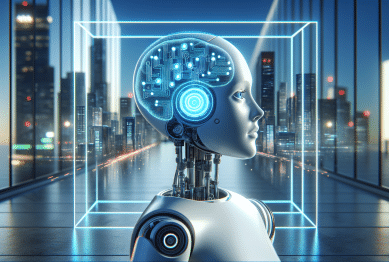Cloud artificial intelligence is changing how organizations operate, but beneath the buzz lies real transformation. Explore how cloud AI platforms, data analytics, security, and scalable machine learning are redefining what’s possible in tech and science, while also surfacing key trends that will shape the future.
Cloud AI: Transforming Technology Foundations
The integration of cloud artificial intelligence into everyday workflows is more than a surface trend. It delivers streamlined access to advanced computational power through remote servers, making data-driven solutions accessible to organizations of every size. With cloud AI, complex tasks like image recognition, natural language processing, and predictive analytics no longer require on-site resources. Decision-makers now find themselves leveraging these scalable capabilities on demand. The impact is dramatic: innovation speeds up, costs shrink, and previously out-of-reach AI potential is within grasp for businesses, researchers, and even individuals. This democratization of AI fosters creative solutions across multiple industries.
Cloud computing’s elasticity complements artificial intelligence perfectly. Instead of purchasing expensive hardware, users can tap into flexible infrastructure, scaling up or down in real-time according to project needs. This flexibility revolutionizes experiment cycles, allowing fast prototyping, model retraining, and adaptation as new data appears. The result? Teams focus on innovation, bypassing the operational headaches once tied to AI deployment. The growing selection of cloud-based AI services, from machine learning tools to cognitive APIs, further reduces technical barriers for emerging technologists and data analysts.
Major providers now compete to deliver cutting-edge cloud AI platforms, offering rich libraries and guided workflows. This ecosystem fuels adoption. With tech leaders providing extensive documentation, resources, and automated options, AI development becomes less daunting. Cloud platforms underlie major advancements in voice assistants, personalized content, and smart health devices. By handling heavy data workloads and complex computational tasks, these services accelerate progress in scientific discovery and application. The cloud’s role in transforming tech’s foundation is only getting stronger as AI continues to evolve.
Building Smart Applications With Machine Learning Platforms
Smart application development thrives on robust machine learning platforms now widely available in the cloud. Developers and businesses can quickly deploy, train, and scale machine learning models without needing specialized infrastructure. APIs make image processing, translation, and anomaly detection accessible—even for users without years of coding experience. As organizations embrace cloud-based machine learning, real-time analytics and adaptive personalization become the norm in customer service, e-commerce, and digital content.
Cloud providers continually expand their set of machine learning tools, introducing user-friendly dashboards, automated model selection, and secure data integration. This blend of usability and power shortens development cycles and broadens who can work with artificial intelligence. Data scientists gain access to distributed processing and GPU-based workloads for deep learning experiments, while those in business roles can build light, process-automating bots through no-code solutions. The convergence fuels new waves of innovation, allowing even traditional industries to experiment with AI-enhanced workflows.
Collaboration flourishes in the cloud. Teams can share data, track model performance, and refine algorithms together—regardless of location. This remote synergy accelerates knowledge transfer and promotes best practices in applied AI. As barriers to entry fall, organizations leverage shared infrastructure and prebuilt models as stepping stones to their own custom solutions. Cloud-based machine learning doesn’t just deliver speed; it unlocks collective intelligence, putting advanced tech within reach for many.
Unlocking Big Data Analytics in the Cloud
Big data analytics was once reserved for companies capable of building their own data centers. Now, cloud-based environments make it feasible for almost anyone to harness the power of data analytics at scale. The cloud’s architecture allows seamless ingestion, storage, and structured querying of vast datasets. As a result, patterns and insights embedded in raw information become actionable—whether for public health, finance, or logistics decisions.
Modern analytics platforms integrate advanced features like real-time dashboards, AI-powered anomaly detection, and distributed storage. Access to these tools via the cloud means that organizations no longer worry about outgrowing physical storage or dealing with slow legacy systems. Instead, they focus on identifying trends, making predictive models, and enabling smarter decisions faster. Data engineers leverage built-in connectors to popular applications, allowing integration across different sources and creating a unified view of information that aids cross-team collaboration.
Security remains a central concern in cloud-based analytics. Providers design their platforms with features like automated backup, advanced encryption, and role-based access controls. These safeguards protect sensitive information and ensure compliance with strict data regulations. Enhanced transparency and audit trails further encourage organizations to transition to cloud-managed analytics, knowing that data privacy is a top priority. As analytics continue to evolve, the cloud’s flexibility and scalability ensure it will remain the backbone of data-driven innovation.
AI Security: Protecting Data and Trust in the Cloud
Artificial intelligence and cloud computing introduce security challenges that must be addressed thoughtfully. As cloud AI platforms process sensitive data, questions arise around privacy, consent, and operational risk. Cybersecurity frameworks built directly into cloud infrastructure help mitigate potential threats. From network firewalls to identity verification mechanisms, every layer of protection is crucial. Organizations are encouraged to conduct regular risk assessments to keep up with evolving tactics used by cybercriminals.
Encryption has become standard practice for cloud services handling confidential information. Whether encrypting data at rest or during transmission, platforms aim to offer strong protection against unauthorized access. Providers offer customizable controls—such as multifactor authentication and anomaly detection systems—to fortify both internal and external defenses. In automated environments, AI-driven threat monitoring relies on continuous machine learning to identify patterns indicating possible breaches. These capabilities help teams respond quickly to incidents, reducing disruption and minimizing data loss.
Regulatory compliance plays a larger role as AI becomes central to critical infrastructure and public services. Governments and standards organizations provide guidelines to ensure ethical and responsible use of cloud-based artificial intelligence. Adopting best practices and transparent reporting fosters trust among users, while technology firms invest in robust audit tools and chain-of-custody records. The path to secure AI in the cloud requires ongoing partnership between providers, organizations, and regulatory bodies, ensuring today’s innovations do not compromise tomorrow’s safety.
How Cloud AI Shapes the Scientific Frontier
Scientific research is undergoing a transformation thanks to cloud-based artificial intelligence. Researchers now process huge biological datasets, simulate molecular interactions, or interpret astronomical data—all without specialized supercomputers on-site. The cloud enables large, global teams to share, refine, and run models from anywhere. This collaborative capability speeds breakthroughs in fields like genomics, environmental science, and astrophysics.
Cloud platforms have become foundational to open science, offering tools for data sharing, reproducibility, and peer review. Transparent access to computational resources broadens research participation, helping smaller institutions and interdisciplinary projects join those at the forefront of discovery. Equally important, automated pipelines and scalable resources make it feasible to rerun complex experiments quickly, accelerating feedback loops and improving reliability of scientific findings.
Ethics and collaboration are central. As more scientific work transitions to cloud-based AI, researchers must navigate issues around data sovereignty, fairness in algorithms, and equitable access to resources. Community-driven initiatives and global standards work in tandem with cloud providers to address these challenges, ensuring ethical stewardship of technology. The next generation of science will be marked by the convergence of cloud AI, team-driven inquiry, and a shared commitment to responsible innovation.
Predicting the Future of Cloud AI Ecosystems
Cloud AI ecosystems evolve rapidly. The interplay between cloud scalability, advanced algorithms, and device interconnectivity forecasts an environment where personalization, automation, and real-time insights become standard. Industries such as healthcare, transportation, and smart manufacturing look to this confluence to optimize efficiency and respond to shifting needs. With the expansion of edge computing and 5G, AI-powered services reach new heights.
Another transformative aspect is the rise of federated learning and privacy-preserving technologies within cloud AI. Models can now be trained collaboratively on decentralized data sources, safeguarding privacy while pooling collective knowledge. These developments are crucial for sectors dealing with stringent privacy requirements, including healthcare and banking. By facilitating broad yet secure AI adoption, federated learning promises to unlock value for diverse stakeholders.
Looking forward, the cloud AI landscape will likely center on inclusivity, universal access, and sustainability. Ongoing innovation aims to reduce energy consumption in massive data centers and lower barriers for global participation. The seamless integration of cloud and AI encourages more industries, communities, and researchers to harness these tools responsibly. The future, shaped by cloud artificial intelligence, is both promising and challenging—a space where human curiosity and computation blend to solve society’s biggest puzzles.
References
1. National Institute of Standards and Technology. (n.d.). Cloud Computing. Retrieved from https://www.nist.gov/programs-projects/cloud-computing
2. Google Cloud. (n.d.). Artificial Intelligence Platform Documentation. Retrieved from https://cloud.google.com/ai-platform/docs
3. Harvard Business Review. (2022). How Cloud Computing Enables Modern AI and Data Analytics. Retrieved from https://hbr.org/2022/07/how-cloud-computing-enables-modern-ai-and-data-analytics
4. Stanford University. (n.d.). AI Ethics and Cloud Computing in Science. Retrieved from https://hai.stanford.edu/news/ethics-ai-cloud-computing-scientific-research
5. European Union Agency for Cybersecurity. (2023). Cloud Security for Artificial Intelligence. Retrieved from https://www.enisa.europa.eu/publications/cloud-security-for-ai
6. MIT Open Learning Library. (n.d.). Data Analytics, Machine Learning, and Cloud Technologies. Retrieved from https://openlearning.mit.edu/resources/courseware/data-analytics-machine-learning-cloud-technologies









